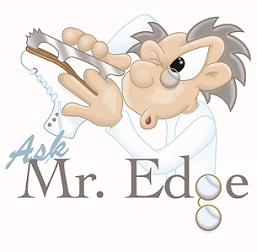By John Harmata
 Fall is quickly approaching and along with it comes the thought of once again enrolling your children in figure skating lessons. When buying new or used skates for a young child, it is helpful to establish a time-line for the child’s shoe-size changes. Doing this will give parents a good idea of how long it might be until their child needs another pair of skates.
Fall is quickly approaching and along with it comes the thought of once again enrolling your children in figure skating lessons. When buying new or used skates for a young child, it is helpful to establish a time-line for the child’s shoe-size changes. Doing this will give parents a good idea of how long it might be until their child needs another pair of skates.
In evaluating used skates, check:
• Both sides of the boot uppers for excess creasing
• Soles and heels for water damage and loose screw holes
• Condition of the leather, including cracking and dryness, on the inside
• General overall support and the firmness of uppers
• The amount of skating edge left on the blade
• The appropriateness of the blade for the skater’s current skill level
Note: Never assume that a newly polished used boot will be good enough to skate in.
Skating Technique
Proper skating technique is relative to how well the boot fits. It makes no difference whether a skater is five or eighty-five; if the boot doesn’t fit correctly, expect problems. Parents know that young beginning skaters will be growing out of their skates before long, and most parents would like to get as much time as possible from a child’s pair of boots. I couldn’t agree more, but there is a limit as to how much larger a skate should be on a child. Very small children’s skates should be no more than a half size over their exact size requirements. Any larger and young skaters will have trouble finding their center point of balance, making balance difficult to maintain while simultaneously trying to learn proper edge technique.
Note: Many young children have very wide feet, and to accommodate this, parents often buy skates that are almost two sizes longer than needed. This common mistake can be avoided by spending a few dollars more on skates that are available in a wider width.
Fitting Technique
Whether young or old, seasoned skater or not, the same fitting technique should be followed when purchasing figure skates.
• Measure both feet, and always fit for the longer foot if feet are not equal.
• Once a pair has been selected, loosen the laces down to the toe area of the boot before placing the foot into it. Note: Loosening the laces makes it easier for skaters to put on and take off their skates. This also ensures that the foot is seated into the boot properly before lacing.
• After the foot is placed into the boot, kick back on the heel of the blade. With the toe of the boot pointed upward, start at the bottom and begin lacing. When finished, there should be about one and one-half (1-1/2) inches of space between the lace holes. Note: A much narrower lacing pattern is an indication that the boots are too big.
• Check the length and width of the boot by standing up and placing weight on it. In new boots, the foot should feel totally flat across the ball area, and the boot should be a bit uncomfortably snug, but not unbearably tight. Also take into account the resting tension of the toes. If the boot is too short, the toes will curl to avoid touching the front of the boot.
• Continue to walk around in the skates for at least ten to fifteen minutes, checking for any arch problems that may develop as a result of either too flat or too high an arch. A burning or cramping sensation under the arch or ball area of the foot needs to be corrected by adjusting the arch with an arch support. If this doesn’t work, try a different brand of skate.
• Walking around for a few minutes also will indicate how well heels are locked into boots. If the boots are already feeling loose around the heels and ankles, it won’t be long before heels start slipping up and out. Solving this problem may require a switch to a different skate brand.
• Bunions, corns, flat or high arches, or other small bones may require adjustments to boots.
Note: If a skater is planning on wearing socks, plain white, lightweight thermo socks are best. Tights or nylons are even better. Heavy wool socks take up a great deal more room in the width of a skate, and are not recommended.
– Guest author, John Harmata
